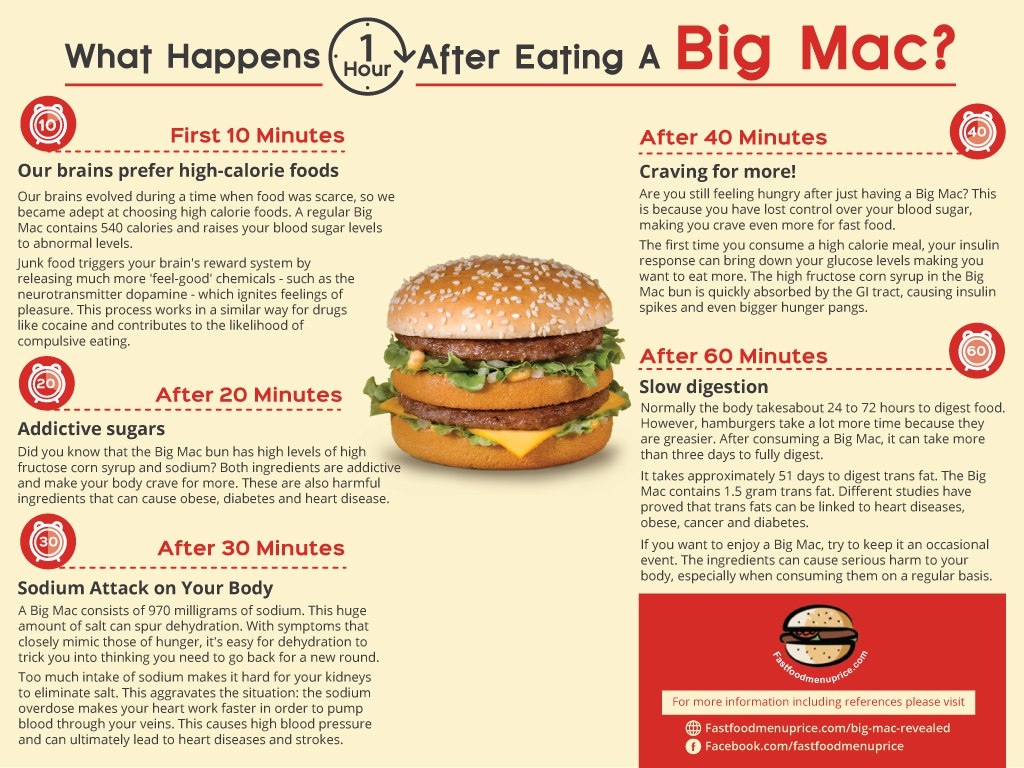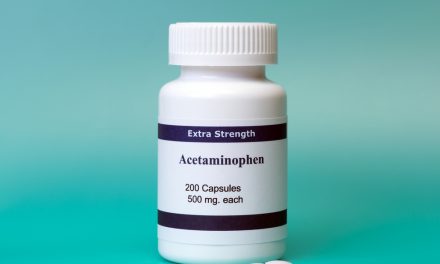You’ve probably heard a lot on how junk food negatively affects your body. You’ve probably also heard about studies carried out on fast food and the ingredients, chemicals and additives they contain. Nevertheless, when your stomach starts to rumble and you are dying for a quick bite, the Big Mac seems just too hard to resist. And once you sink your teeth into it, all the studies with their cautionary information are simply forgotten by the rush of quickly consuming the nice and juicy Big Mac.
But, maybe you need to take a better look at this appetizing burger. We have summarized the ingredients of the Big Mac and their effects on your body. You’ll notice that it’s not that easy at all to order a healthy meal. Lets take a look at what the Big Mac does to your body.
What Happens One Hour After Eating A Big Mac?
First 10 Minutes–Our brains prefer high-calorie foods
- Our brains evolved during a time when food was scarce, so we became adept at choosing high calorie foods. A regular Big Mac (with cheese and sauce) contains 540 calories and raises your blood sugar levels to abnormal levels.
- Junk food triggers your brain’s reward system by releasing much more ‘feel-good’ chemicals – such as the neurotransmitter dopamine – which ignites feelings of pleasure. This process works in a similar way for drugs like cocaine and contributes to the likelihood of compulsive eating.
After 20 Minutes–Addictive sugars
- Did you know that the Big Mac bun has high levels of high fructose corn syrup and sodium? Both ingredients are addictive and make your body crave for more. These are also harmful ingredients that can cause obese, diabetes and heart disease.
After 30 minutes –Sodium Attack on Your Body
- A Big Mac Consists of 970 milligrams of sodium. This huge amount of salt can spur dehydration. With symptoms that closely mimic those of hunger, it’s easy for dehydration to trick you into thinking you need to go back for a new round.
- Too much intake of sodium makes it hard for your kidneys to eliminate salt. This aggravates the situation: the sodium overdose makes your heart work faster in order to pump blood through your veins. This causes high blood pressure and can ultimately lead to heart diseases and strokes.
After 40 minutes –Craving for more!
- Are you still feeling hungry after just having a Big Mac? This is because you have lost control over your blood sugar, making you crave even more for fast food.
- The first time you consume a high calorie meal, your insulin response can bring down your glucose levels making you want to eat more. The high fructose corn syrup in the Big Mac bun is quickly absorbed by the GI tract, causing insulin spikes and even bigger hunger pangs.
After 60 minutes –Slow digestion
- Normally the body takes about 24 to 72 hours to digest food. However, hamburgers take a lot more time because they are greasier. After consuming a Big Mac, it can take more than three days to fully digest.
- It takes approximately 51 days to digest trans fat. The Big Mac contains 1.5 gram trans fat. Different studies have proved that trans fats can be linked to heart diseases, obese, cancer and diabetes.
- If you want to enjoy a Big Mac, try to keep it an occasional event. The ingredients can cause serious harm to your body, especially when consuming them on a regular basis.
Now, let’s take a close look at the ingredients as listed on the McDonald’s website and how they match with the infographic.
Note: these are the US ingredients.
Big Bun with a Sprinkling of Sesame Seeds
Ingredients: Enriched Bleached Flour (Wheat Flour, Malted Barley Flour, Niacin, Reduced Iron, Thiamin Mononitrate, Riboflavin, Folic Acid), Water, High Fructose Corn Syrup, Yeast, Soybean Oil, Contains 2% or Less: Salt, Wheat Gluten, Sesame Seeds, Leavening (Calcium Sulfate, Ammonium Sulfate), May Contain One or More Dough Conditioners (Sodium Stearoyl Lactylate, DATEM, Ascorbic Acid, Azodicarbonamide, Mono and Diglycerides, Monocalcium Phosphate, Enzymes, Calcium Peroxide), Calcium Propionate (Preservative).
CONTAINS: WHEAT.
Okay, so, how much damage can that do? After all, isn’t it just flour, yeast, salt and water? True, but it also contains high fructose corn syrup, sugar, and wheat and soy lecithin[1]. You wonder why you always want to eat up a Big Mac as soon as possible? That’s because all these additives act as taste enhancers and make you crave for more. They also enhance the risk on heart diseases and diabetes. Besides the generous sprinkling of sesame seeds, you also have azodicarbonamide. Still struggling to get the pronunciation right? It gives your bun that delicious white color by bleaching it. Unfortunately, it is also a carcinogenic (causing cancer).
And there’s more: the big bun is made of white flour that has been shelled while the healthy bran is removed. Normally this bran contributes to the full feeling you have after eating. Without it, you’re getting hungry again just after finishing your Big Mac. Also, without the fiber your insulin levels are triggered to rise to abnormal levels. Moreover, by eating white flour regularly over a period of five years, your chances of getting overweight increase by 40%[2]. . Still wondering why there is so much overweight in the States?
Yummy Slices of Golden Cheese
Ingredients: Milk, Cream, Water, Cheese Culture, Sodium Citrate, Contains 2% or Less of: Salt, Citric Acid, Sodium Phosphate, Sorbic Acid (Preservative), Lactic Acid, Acetic Acid, Enzymes, Sodium Pyrophosphate, Natural Flavor (Dairy Source), Color Added, Soy Lecithin (Added for Slice Separation).
CONTAINS: MILK AND SOY LECITHIN
Now, that’s just a dairy product right? The whole world eats cheese, so why is it on the list of scary ingredients? Check its composition and you’ll see a list of chemicals that don’t look like they come from a cow. You’ll see salt or sodium, preservatives, added coloring and soy lecithin that prevents the cheese slices from sticking to each other[3]. And they have a suspicious additive, “natural flavor from dairy source.” Now, why would anyone want to add dairy flavor to cheese?
Juicy Beef Patty
Ingredients: 100% Pure USDA Inspected Beef; No Fillers, No Extenders.
Prepared with Grill Seasoning (Salt, Black Pepper).
This one has to be safe. The company specifies that it’s 100% pure meat and has no fillers or extenders. It also has the USDA approval. The difficulty? To get that nice juicy burger on your Big Mac it needs to be processed and transformed. Most probably chemicals have been added: we all recall the pictures of the McDonalds hamburger after a few years: they still look perfectly eatable. Let’s also not forget the sodium it contains: this can do some damage to your heart[4].
Generous Dollop of Sauce
Ingredients: Soybean Oil, Pickle Relish (Diced Pickles, High Fructose Corn Syrup, Sugar, Vinegar, Corn Syrup, Salt, Calcium Chloride, Xanthan Gum, Potassium Sorbate [Preservative], Spice Extractives, Polysorbate 80), Distilled Vinegar, Water, Egg Yolks, High Fructose Corn Syrup, Onion Powder, Mustard Seed, Salt, Spices, Propylene Glycol Alginate, Sodium Benzoate (Preservative), Mustard Bran, Sugar, Garlic Powder, Vegetable Protein (Hydrolyzed Corn, Soy and Wheat), Caramel Color, Extractives of Paprika, Soy Lecithin, Turmeric (Color), Calcium Disodium EDTA (Protect Flavor).
CONTAINS: WHEAT, EGG AND SOY
The Big Mac wouldn’t be a Big Mac without the sauce, now would it? The issue is that the list of 33 ingredients aren’t exactly appetizing. In addition to the high fructose syrup, sodium, preservatives and others, you have a special additive; propylene glycol. Nope. That’s not a fancy name for a spice. You’ll find it in shampoo, engine coolants and its even used as an anti-freeze[5].
Tangy Pickles
Ingredients: Cucumbers, Water, Distilled Vinegar, Salt, Calcium Chloride, Alum, Potassium Sorbate (Preservative), Natural Flavors (Plant Source), Polysorbate 80, Extractives of Turmeric (Color).
That’s just cucumbers in vinegar. Why are they a problem? They’re processed, and contain salt.
The Big Mac must have some saving grace. It does. In the form of the shredded lettuce and onions. Unfortunately, their quantity is too little to compensate for the damage the other stuff can do to your body. Now that you know better what the visible stuff can do, let’s see what the invisible additions can do to you.
Calories
Calories are scary to think about. When you think about them in context with the Big Mac, it’s getting even scarier. For instance: if you allow yourself just 2,000 calories a day – the maximum number of calories a regular woman needs – a Big Mac takes more than a quarter of that.
That’s right. This sandwich has 540 calories all by itself. As you can see in the Infographic this is WITHOUT cheese and sauce. That’s 38% of the maximum a woman should take[6].
Have you ever seen someone eating a ‘naked’ Big Mac? Nope, neither did I. You’ll want something to wash it down with, so you order a large, chilled Coke and that sets you back by another 260 calories. If you absolutely must have a side order (and of course you do!), those large fries are going to cost you another 500 calories. Count that up and you have 1,330 calories. That’s a big slice of the 2000 calories a woman should consume in a single day. If you’re on a diet, or simply don’t compensate for it later that day, you’ll have a “Big” problem on your waistline[7].
Fat
On a 2000-calorie diet, you should limit yourself to 60 gr of fat. Of this total, 20 gr at the most, should be saturated fat. Now let’s take a look at our favorite hamburger: the Big Mac contains 29 gr of fat of which 10 gr saturated. That’s about half the limit you’re allowed in a day! The sandwich also contains 1.5 gr of trans fat. Besides worrying about the weight gain, you also need to consider the effects of trans fat to your cholesterol and risk of heart disease[8]. The Harvard School of Public Health states that trans fat raises your bad cholesterol levels and argues that it should be eliminated completely from your diet. Apparently, the trans fat swells up your gut and hampers your body in producing neurotransmitters such as dopamine and serotonin. These chemicals make you feel full after the meal. Without these essential biological chemicals, you’ll be dying for some food very soon again[9].
Wish to get started on those delicious fries that you ordered on the side? Probably not, because that’s 25 gr of fat including 2.5 gr of saturated fat.
Sodium
The Big Mac contains lots of sodium. Sodium does not make you gain weight, but it makes your cells retain water. And that’s the reason why you feel bloated. You can safely ingest 2,300 milligrams of sodium in a day but eat a Big Mac and you’ll be consuming 970 milligrams or 42% of your daily allowed limit. And, if you’ve been advised a low-sodium diet, you’ll be eating 88% of what you can have. Did you notice? We haven’t mentioned the fries yet.
Eating excessive sodium makes your heart work extra hard and that can raise your blood pressure, and chances of heart trouble and strokes. Your kidneys also work harder to process all this excessive sodium. As a result, very soon after the meal, you start to feel dehydrated and really thirsty. The problem is that the body often mistakes thirst for hunger, so you might think you’re hungry again. And, when you’re looking for a quick energy-booster, your brain is going to direct you to the desserts. So, now you know why you crave for that ice cream afterwards.
Sugar
Many people are under the impression that if they eliminate the Coke from their meal, this should help them slash their sugar intake. Well, that doesn’t really work. True, your Big Mac has only 9 gr of sugar, but – as you’ve already noticed in the infographic – it also contains high fructose corn syrup. Moreover, there’s sugar in the sauce and the condiments too.
Here’s how your digestion works. The food you eat is converted into glucose, a form of sugar. As soon as your pancreas senses the glucose in your blood, it releases a hormone, insulin. Insulin converts glucose into energy and transfers some of it to your cells so they can function. The rest is stored for later energy use. When you’re calorie intake exceeds your energy use, the released glucose is stored as fat. Unfortunately for you, there is practically no limit on how many calories your body can store as fat. Taking too many calories for a prolonged period of time increases your risks of diabetes.
What You Can do
It’s perfectly understandable that you want to indulge yourself once in a while. True, an occasional Big Mac might not really harm you. Try to opt for a salad to go with it instead of the fries and call for a low-fat dressing on the side so you can limit your calorie intake. If you must have the fries, share them with someone else and try to have them without the sauce. But then again: what’s the fun in nude fries with no sauce? You could also add a yogurt parfait to satisfy the sweet cravings that you’ll get after having a sodium-laden meal. And the best tip? Skip the soda. Have a glass of water or iced tea without the sugar.
You might think that having a Diet Coke is safe. But, it’s also a fact that having had a sugar-free drink only makes you pile on other kinds of sugars during the rest of the day. You’ll feel like you’ve earned them.
But, it’s not all bad news. There are people – like Rosinlof, a salesman based in Utah – who can eat all the Big Macs they want and show no signs whatsoever of having any kind of health problems. How they do it? You could try Rosinlof’s secret: he doesn’t eat anything much besides a couple of Big Macs a day[10].
So, go ahead and enjoy that Big Mac. Just enjoy it responsibly, and you’ll be okay.
 Erin Elizabeth is a long time activist with a passion for the healing arts, working in that arena for a quarter century. Her site HealthNutNews.com is less than 2 years old, but has already cracked the top 20 Natural Health sites world-wide. She is an author, public speaker, and has recently done some TV and film programs for some of her original workwhich have had international media coverage. You can get Erin’s e-book for free here and also watch a short documentary on how she overcame vax injuries, Lyme disease, a significant weight gain, and more. Follow Erin on Facebook, Twitter, and Instagram.
Erin Elizabeth is a long time activist with a passion for the healing arts, working in that arena for a quarter century. Her site HealthNutNews.com is less than 2 years old, but has already cracked the top 20 Natural Health sites world-wide. She is an author, public speaker, and has recently done some TV and film programs for some of her original workwhich have had international media coverage. You can get Erin’s e-book for free here and also watch a short documentary on how she overcame vax injuries, Lyme disease, a significant weight gain, and more. Follow Erin on Facebook, Twitter, and Instagram.













